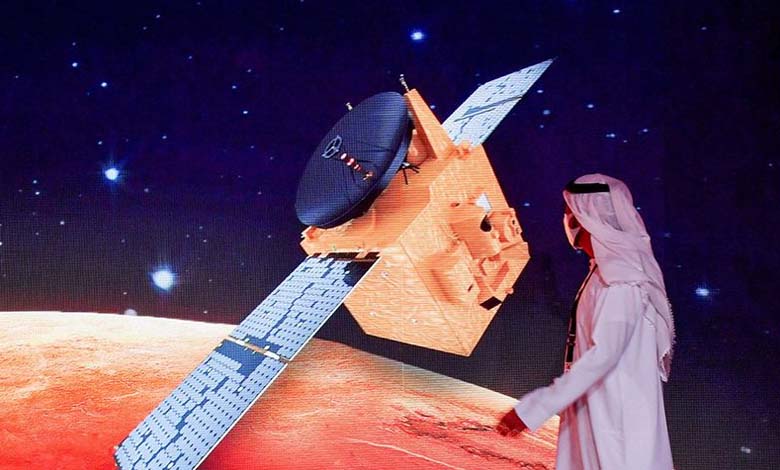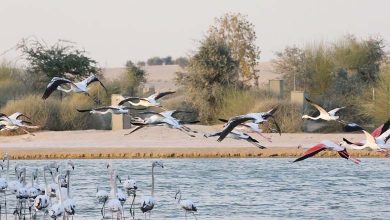Achievements in the Emirates Mars Mission: “Hope Probe” in a Full Martian Year

The Emirates Mars Exploration Project, represented by the “Hope Probe,” the first exploration mission conducted by an Arab country, has announced a series of new and unique discoveries derived from the initial measurements of the Martian atmosphere over a full Martian year.
This announcement marks three years since the scientific data collection on the Red Planet began, confirming the achievement of the mission’s declared scientific objectives.
Salem Butti Al Qubaisi, the Director General of the UAE Space Agency, stated, “The Emirates Mars Exploration Mission was designed to create a national challenge that contributes to accelerating and developing not only the engineering capabilities of the country but also to revolutionize our educational and research system and enhance our innovation. There is no doubt that the mission has succeeded in achieving this and exceeded our expectations.”
He added, “From the outset, the leadership of the UAE has made it clear that the Emirates Mars Exploration Project must make significant scientific contributions, and we can now say that the mission has not only achieved its core scientific objectives but has surpassed them significantly.”
The Emirates Mars Exploration Project was designed to achieve three scientific objectives and answer questions posed by scientists in the Mars Exploration Analysis Group (MEPAG). The “Hope Probe” was launched to monitor seasonal and diurnal changes in the atmosphere as well as annual changes, including those caused by solar impact, which leads to the depletion of the upper layer of the Martian atmosphere, especially hydrogen and oxygen, in addition to studying the temporal and spatial behavior of the red planet.
Hura Al Mazrouei, Director of the Emirates Mars Exploration Project, said, “We can confidently say that the Emirates Mars Exploration Mission has significantly exceeded its declared scientific objectives… We have not only achieved our scientific goals but have extended the journey of the Hope Probe and contributed to new and unique scientific discoveries, including the discovery of new forms of Martian auroras, as well as providing new and more comprehensive images of the lesser-known Martian moon, Deimos.”
Mohsen Al Awadhi, Director of Space Missions Management at the UAE Space Agency, stated, “The unique heliocentric orbit of the Hope Probe supports these unique explorations, providing us with a complete picture of the dynamics of the planet’s atmosphere every nine days. This has enabled us to obtain stunning imagery of Mars‘ atmospheric changes day and night, across seasons, over a full Martian year.”
The scientific team of the Hope Probe shared, on the third anniversary of the probe entering orbit, a series of remarkable images, including an animation illustrating changes in oxygen emissions over a Martian year, captured by the Emirates Mars Ultraviolet Spectrometer (EMUS) and collected at Martian local times between 9 am and 3 pm, revealing atomic oxygen emissions at a wavelength of 130.4 nanometers, highlighting the active dynamics of the upper atmosphere of Mars and the processes leading to its gradual escape into space.
The ultraviolet spectrometer images also highlighted variations in oxygen levels over a Martian year as the planet approaches the sun, which had never been observed in this way before this mission.
Additionally, the scientific team presented images from the Emirates Mars Infrared Spectrometer (EMIRS), showing daily global maps of dust and ice over a full Martian year, facilitating analysis and deep understanding of the daily variations of these elements.
To conclude this series, the scientific team presented images from the Emirates Mars Ultraviolet Spectrometer (EMUS), illustrating the visual changes of the planet through a series of 12 images taken over a full Martian year, reflecting the effects of seasonal changes on Mars.
The Hope Probe carries three innovative scientific instruments, including the Emirates Mars Ultraviolet Spectrometer (EMUS), which measures oxygen and carbon monoxide in the Martian thermosphere as well as hydrogen and oxygen in the Martian exosphere.
Furthermore, the Emirates Mars Infrared Spectrometer (EMIRS) measures temperatures, dust distribution, water vapor, and icy clouds in the lower atmosphere, while the Emirates Mars Ultraviolet Spectrometer (EMUS) measures oxygen and carbon monoxide in the Martian thermosphere as well as hydrogen and oxygen in the Martian exosphere.
The launch of the Emirates Mars Exploration Project (Hope Probe) is the culmination of knowledge transfer and development efforts that began in 2006 at the Mohammed bin Rashid Space Centre, the result of close collaboration between a team of Emirati experts in science, research, and space engineering, and international partners from around the world, to develop the necessary capabilities for designing and engineering space missions.
The Hope Probe weighs approximately 1,350 kilograms, equivalent to a small four-wheel-drive vehicle, and was designed and developed by engineers at the Mohammed bin Rashid Space Centre in collaboration with academic partners, including the Laboratory for Atmospheric and Space Physics at the University of Colorado Boulder, the University of Arizona, and the University of California, Berkeley.












